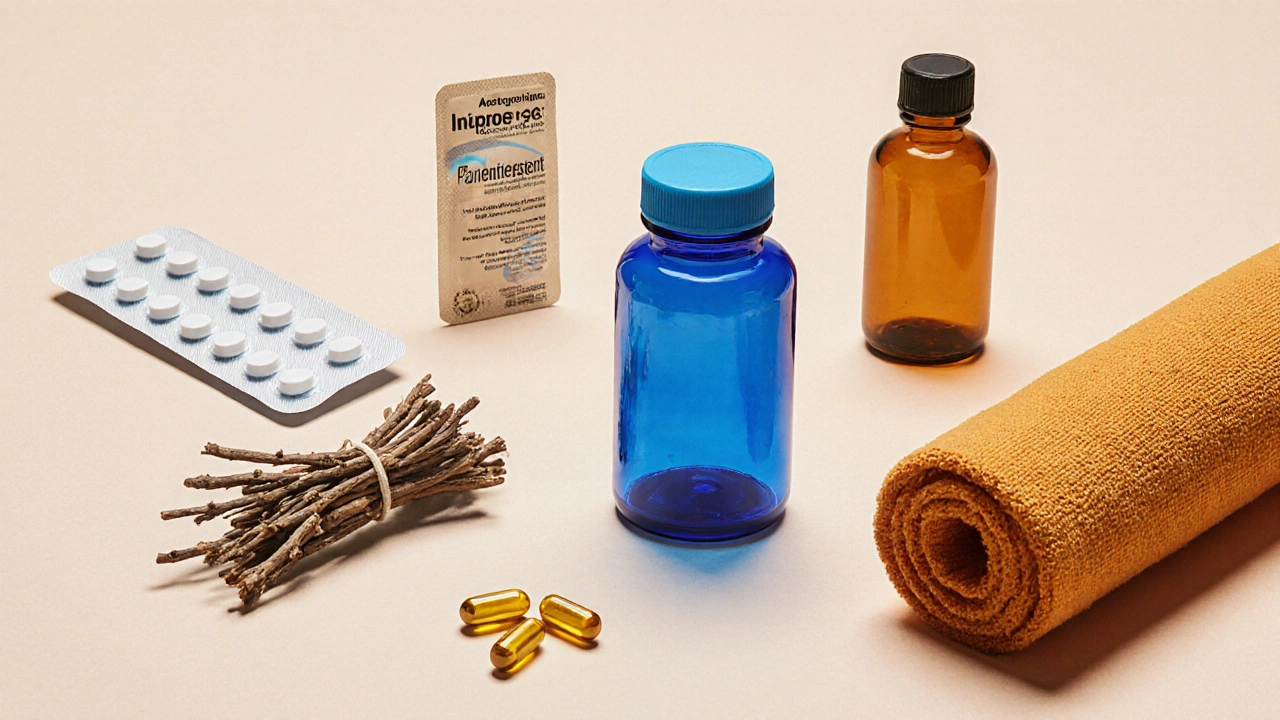Pain Reliever Decision Tool
When a headache pops up or a sore muscle slows you down, the first question is: which pain reliever should you reach for? Tylenol is the brand name most people recognize for acetaminophen, a widely used over‑the‑counter analgesic and antipyretic. It promises quick relief with a low risk of stomach upset, but how does it truly compare to other go‑to options like ibuprofen, naproxen, or even natural remedies? This guide breaks down the science, safety, and practical considerations so you can pick the right pill-or alternative-without guessing.
Key Takeaways
- Acetaminophen (Tylenol) is best for fever and mild‑to‑moderate pain when stomach irritation is a concern.
- Ibuprofen and naproxen provide stronger anti‑inflammatory action but carry higher GI and kidney risks.
- Aspirin is useful for cardiovascular protection but isn’t ideal for everyday pain relief.
- Natural options such as willow bark or turmeric can help mild pain but lack the consistency of drugs.
- Choosing the right product depends on age, health conditions, drug interactions, and cost.
How Tylenol (Acetaminophen) Works
Acetaminophen reduces pain by acting on the brain’s pain‑processing pathways and lowers fever by influencing the hypothalamic heat‑regulation center. Unlike NSAIDs (non‑steroidal anti‑inflammatory drugs), it doesn’t block the cyclooxygenase (COX) enzymes that produce inflammation in peripheral tissues. This explains why Tylenol is gentle on the stomach but also why it offers limited anti‑inflammatory benefits.
Typical adult dosing: 500mg to 1g every 4-6hours, not exceeding 3g per day for most adults (4g only under medical supervision). For children, the dose is weight‑based, usually 10-15mg/kg every 4-6hours, max 75mg/kg per day.
Comparing the Main Alternatives
Below is a side‑by‑side look at the most common over‑the‑counter pain relievers, plus two popular natural options. The table captures dosage, onset, duration, and safety flags you’ll need to weigh.
| Drug / Remedy | Typical Dose | Fastest Onset | Duration of Relief | Anti‑Inflammatory? | GI/Kidney Risk | Best For |
|---|---|---|---|---|---|---|
| Tylenol (Acetaminophen) | 500mg‑1g every 4-6h (max 3g) | 30min | 4-6h | No | Low (liver overload if over‑dosed) | Fever, mild‑to‑moderate pain, children |
| Ibuprofen (Advil, Motrin) | 200‑400mg every 6-8h (max 1.2g) | 15-30min | 6-8h | Yes | Moderate (GI irritation, kidney strain) | Muscle aches, joint pain, inflammation |
| Naproxen (Aleve) | 220‑440mg every 8-12h (max 660mg) | 30-60min | 8-12h | Yes | Higher (GI bleed, cardiovascular risk) | Long‑lasting aches, arthritis |
| Aspirin | 325‑650mg every 4-6h (max 4g) | 15-30min | 4-6h | Yes (weak) | High (GI bleed, Reye’s syndrome in kids) | Cardiovascular protection, mild pain |
| Willow Bark | 240‑480mg of salicin extract | 45min | 4-6h | Yes (natural salicylate) | Moderate (similar to aspirin) | People preferring herbal options |
| Turmeric (Curcumin) supplement | 500‑2000mg standardized extract | 1-2h | 6‑12h | Weak | Low (but may interact with blood thinners) | Chronic low‑grade inflammation |
| Heat Therapy | - | Immediate | Variable | No | None | Muscle spasm, stiffness |

When to Choose Tylenol Over the Rest
If you’re dealing with a fever, a tension headache, or post‑vaccination soreness, Tylenol’s rapid antipyretic effect makes it a first‑line choice. Its lack of COX inhibition means it won’t aggravate an already sensitive stomach, which is a big plus for people on acid‑suppressing meds or those with a history of ulcers.
Children under 12years old are often given acetaminophen instead of ibuprofen because ibuprofen can sometimes cause mild stomach upset, and dosing formulas are clearer for kids. However, never give aspirin to children or teenagers with viral infections-the risk of Reye’s syndrome outweighs any pain‑relief benefit.
When NSAIDs Beat Acetaminophen
For inflammation‑driven pain-think sprained ankle, arthritis flare‑up, or menstrual cramps-an NSAID like ibuprofen or naproxen typically provides more relief because it reduces prostaglandin production at the site of injury. Naproxen’s longer half‑life means you’d only need to dose twice a day, which is handy for chronic conditions.
People with cardiovascular disease might favor low‑dose aspirin for its platelet‑inhibiting effect, but that’s a separate therapeutic goal, not pure analgesia. Always discuss daily aspirin use with a doctor.
Safety Flags: Liver vs. Stomach vs. Kidneys
Acetaminophen is metabolized in the liver. The main danger is exceeding the daily maximum, especially if you also drink alcohol or take other acetaminophen‑containing products (like cold syrups). Symptoms of overdose-nausea, loss of appetite, dark urine-require urgent medical attention.
NSAIDs, on the other hand, can irritate the gastric lining and, in high‑risk individuals (elderly, chronic kidney disease, dehydration), impair kidney function. Taking ibuprofen with a high‑salt meal or staying well‑hydrated can mitigate some risks, but they don’t disappear.
Natural salicylates (willow bark) share aspirin‑like GI concerns, while turmeric is generally safe but may thin the blood if you’re already on anticoagulants.
Cost, Availability, and Insurance Coverage
Generic acetaminophen tablets cost as little as $0.05 per pill at most pharmacies, making it the most budget‑friendly option. Ibuprofen and naproxen are similarly inexpensive, though brand‑name versions can run higher. Herbal supplements vary widely-quality‑controlled willow bark extracts are often $10‑$20 for a month’s supply.
Many health insurance plans cover over‑the‑counter purchases through flexible spending accounts, but they rarely differentiate between brands. If you’re looking to stretch a dollar, buying the generic version of each drug usually yields the best price‑per‑dose ratio.

Quick Decision Checklist
- Fever? Choose Tylenol.
- Stomach sensitivity? Avoid ibuprofen/naproxen; go with Tylenol.
- Inflammation (joint, muscle)? Prefer ibuprofen or naproxen.
- Cardiovascular protection needed? Low‑dose aspirin under doctor guidance.
- Prefer natural? Try willow bark or turmeric, but keep expectations realistic.
- Kidney disease or dehydration? Limit NSAIDs; acetaminophen is safer.
Practical Tips for Safe Use
- Read labels for hidden acetaminophen in combo cold medicines.
- Stick to the recommended daily max-don’t double‑dose for severe pain.
- Space NSAID doses at least 6hours apart, and take with food.
- If you’re on blood thinners, avoid high‑dose aspirin and discuss turmeric supplements with your doctor.
- Store all meds out of children’s reach; use child‑proof caps.
Frequently Asked Questions
Can I take Tylenol and ibuprofen together?
Yes, alternating them can provide better pain control while keeping each dose within safe limits. For example, take ibuprofen every 6hours and Tylenol every 4hours, but never exceed the daily maximum of either.
Is Tylenol safe for pregnant women?
Acetaminophen is generally considered safe during pregnancy when used at recommended doses. NSAIDs are avoided, especially in the third trimester, because they can affect fetal circulation.
What’s the difference between Tylenol and Tylenol PM?
Tylenol PM adds diphenhydramine, an antihistamine that causes drowsiness, to help you sleep. It’s useful for nighttime pain but not for daytime use.
Can I use willow bark instead of aspirin?
Willow bark contains salicin, which the body converts to a compound similar to aspirin. It works for mild pain, but the dosage is less standardized, and it still carries a risk of stomach irritation.
Why does my doctor recommend Tylenol for my child’s fever?
Acetaminophen lowers body temperature quickly and is gentle on a child's developing stomach. Ibuprofen is also safe for kids over 6months, but many parents prefer Tylenol for its simplicity.
Next Steps
If you’ve identified the situation that matches the checklist, grab the appropriate product from your local pharmacy or online retailer. For chronic conditions like arthritis, talk to your physician about a long‑term NSAID plan or possibly a low‑dose aspirin regimen.
Still unsure? Keep a short log of your pain episodes, noting what you took, the dose, and how long relief lasted. Bring that log to your next medical visit-that data helps the doctor tailor the safest, most effective regimen for you.

Monika Kosa
October 12, 2025 AT 00:08Hey there, just a friendly heads‑up that the big pharma giants love pushing acetaminophen because it keeps you buying their cheap generics while they hide the real risks in the fine print – they don’t want you to know how often liver damage slips through the cracks, especially when you’re also sipping that “healthy” green tea they sponsor. Also, did you notice how the government’s health agencies always quote the same numbers? It’s almost like they’re in on the same secret plan to keep NSAIDs off the shelves and make Tylenol the default. Stay safe and keep an eye on the label, the truth is out there! 😊
Gail Hooks
October 13, 2025 AT 03:54In the grand tapestry of cultural health wisdom, we see that each community weaves its own remedy narratives 🌍🧭. While Tylenol whispers comfort to a fevered brow, ibuprofen shouts a battle cry against inflammation. It’s a delicate dance of choice, and remembering that balance honors the ancestors who taught us to listen to our bodies. May your decisions be guided by both science and spirit. ✨
Derek Dodge
October 14, 2025 AT 07:41nice quick tip about not doule dosing.
AARON KEYS
October 15, 2025 AT 11:28Just a quick note on terminology: the article correctly distinguishes between 'acetaminophen' (the chemical name) and 'Tylenol' (the brand name), which helps avoid confusion when reading labels. Also, remember that 'NSAID' stands for non‑steroidal anti‑inflammatory drug, a useful acronym to keep in mind. Proper usage of these terms makes discussions much clearer for everyone.
Summer Medina
October 16, 2025 AT 15:14Listen up fellow readers the truth about acetaminophen is that it is a tool of the global health elite designed to keep the population docile and dependent on manufactured relief without ever addressing the root causes of pain you see the pharmaceutical conglomerates have built an empire on the backs of everyday people who trust the label on the bottle but never question why the same ingredients appear in every over‑the‑counter product it is a clever strategy to monopolize the market while keeping the public shackled to a cycle of consumption the chemistry behind acetaminophen is simple yet the marketing is anything but it disguises the potential for liver toxicity by flooding the packaging with reassuring language and bright colors you think you are safe but the hidden danger lies in the cumulative dose especially when combined with other medicines that also contain the same compound the regulatory bodies claim they are protecting us but their guidelines often mirror the interests of the manufacturers they set the maximum daily dose at three grams for adults which is a number conveniently low enough to avoid immediate crisis yet high enough to keep the sales flowing when you look at the data from hospitals there is a clear correlation between increased acetaminophen sales and spikes in liver failure cases this is not coincidence it is a pattern that demands scrutiny the internet forums are full of personal stories of families losing loved ones to what they thought was a harmless fever reducer the narrative pushed by the media focuses on the comfort it provides while ignoring the silent epidemic of organ damage the solution is not to shun acetaminophen altogether but to educate ourselves demand transparent labeling and push for stricter monitoring of drug interactions the power to change lies in our hands if we refuse to be passive consumers we can demand a healthcare system that prioritizes true well‑being over profit
Melissa Shore
October 17, 2025 AT 19:01While I appreciate the friendly tone earlier I must point out that the dosage guidelines are essential and should not be glossed over the maximum daily limit of 3 grams for adults is there for a reason and exceeding it can lead to serious liver issues please always read the label and consider any other acetaminophen‑containing products you might be taking as well as your overall health status it’s a simple precaution that can prevent major complications
Maureen Crandall
October 18, 2025 AT 22:48Just wanted to add that mixing Tylenol with other meds can be risky especially if you have hidden conditions that aren’t obvious to a casual observer
Michelle Pellin
October 20, 2025 AT 02:34When the evening light casts long shadows upon the kitchen counter, one can almost hear the silent chorus of tiny aches pleading for relief. In such moments, the choice between Tylenol’s gentle lullaby and ibuprofen’s vigorous march becomes a dramatic soliloquy of health and comfort. May your selections be as elegant as a well‑crafted sonnet, guiding you toward serenity without the discord of adverse effects.
Keiber Marquez
October 21, 2025 AT 06:21Look folks the US is best and we dont need foreign drugs we got Tylenol and it work good enough dont listen to other countries they overcomplicate stuff
Lily Saeli
October 22, 2025 AT 10:08Choosing wisely is a moral duty because every pill we take reflects our respect for the body we were entrusted with.